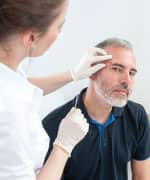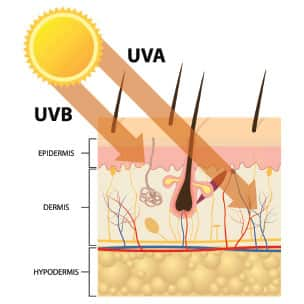Life Extension Magazine®
Aging skin is more than a cosmetic issue.
It is a warning sign of loss to the skin’s integrity and functionality that can impact our overall health.
Studies published last year show that astaxanthin—a carotenoid that gives the vibrant red color to salmon, krill, and shrimp1-3—also helps maintain skin function and structural integrity.4,5
Researchers have identified the ability of astaxanthin to address two different skin concerns:
- Wrinkles and loss of moisture from aging skin,4 and
- UV-induced skin damage, one of the most potent skin-aging accelerators known.5
Because of the skin’s multiple functions, astaxanthin can play an important supporting role in a nutritional strategy to boost skin health.
New research findings show significant benefit of oral astaxanthin in maintaining healthier skin from within.
What you need to know
- Astaxanthin is a potent oxidative stress-reducing carotenoid molecule that has an impressive reputation for its cancer-fighting abilities.
- Those same properties are showing promise for maintaining skin integrity and function with advancing age.
- New studies show that astaxanthin slows age-related skin deterioration and fights UV-induced damage that can lead to cancer and loss of skin integrity.
- Given its proven body-wide impact, astaxanthin makes a perfect complement to any healthy skin-care routine, and may prove more effective at preventing age-induced skin and systemic problems.
The Important Function of the Skin

The skin is the body’s largest organ, and it has a multitude of important functions.
Our skin acts as an important barrier against infection, it helps maintain the body’s hydration and temperature, and it serves as the frontline of immune protection against environmental toxins and microbes.
So while the development of wrinkles and dry, damaged skin may seem to be a cosmetic indication of advancing age, it’s really a warning sign that this important organ isn’t functioning as well as it should be.
When the skin’s structure starts to deteriorate, it can compromise our ability to stay properly hydrated as well as the skin’s essential barrier function against the external environment.
Astaxanthin has multiple properties that make it a promising candidate for protecting the appearance—and function—of the skin.
Astaxanthin Slows Skin Deterioration
A recent study conducted by a research group in Japan showed that astaxanthin can help combat some of the negative effects of two of the main underlying causes of skin aging: UV exposure and air pollution.
Researchers found that treating skin cells in culture with astaxanthin had two skin-protecting actions:
- First, it suppressed the production of inflammatory cytokines (signaling molecules) that follows exposure to UV light.4
- Second, it reduced the secretion of an enzyme (MMP-1)4 that increases when skin is exposed to air pollution.6 This enzyme breaks down the very structure of skin and contributes to wrinkle formation.4,6-9 By reducing MMP-1, astaxanthin may be able to fight wrinkles from multiple causes.6
Clinical Trial of Astaxanthin
Based on these encouraging lab results, researchers decided to test astaxanthin’s capabilities in a real-world setting. To do so, they gave 65 healthy women either astaxanthin (6 mg or 12 mg) or a placebo every day for 16 weeks.4 The results of this human study were published in 2017.
During this relatively short time, the placebo group experienced worsening wrinkles, reduced moisture content, and increases in markers of inflammation in the skin.
In stark contrast, no significant deterioration occurred in the skin of the women taking astaxanthin, and they didn’t have any increases in inflammatory markers.
This was a visible demonstration of astaxanthin’s ability to prevent wrinkles and protect skin’s important moisture barrier.
What makes these results especially noteworthy is that this study was completed between August and December. These months are when skin deterioration is at its highest in Japan because of shifting factors such as UV light and low humidity.
Astaxanthin’s ability to produce impressive results in the face of such major stressors further speaks to its effectiveness.
A Track Record of Success
Previous studies support astaxanthin’s anti-aging skin benefits. These studies show that astaxanthin:
- Improves skin wrinkles, skin elasticity, and texture, and boosts skin moisture content while reducing skin water losses.10,11
- Inhibits the underlying processes that produce wrinkles, age spots, and other unsightly pigmented skin areas associated with aging.10-13
- Enhances collagen production in skin cells, an action that helps to maintain or restore skin’s youthful plumpness and firmness.14
All of these studies make it clear that astaxanthin is not only useful for preventing the visible manifestations of skin aging—but also for protecting some of its critical barrier functions such as water retention.
Additional evidence shows how astaxanthin fights against the damage caused by the most powerful driving force behind skin aging: UV radiation.
Astaxanthin Prevents UV-Induced Skin Damage

Astaxanthin has been shown to help reduce the skin damage and aging caused by UV rays.
Astaxanthin’s unique chemical structure makes it a natural UV-absorber. It’s like a sponge that soaks up that bad stuff so that your skin doesn’t have to.
But astaxanthin has other fundamental properties that help reduce the impact of harmful UV rays—and another 2017 study from Japan reveals some details of those actions.5
In mice not given astaxanthin, chronic exposure to UV light increased water loss across the skin barrier and accelerated the formation of visible wrinkles.
A closer look on the molecular level revealed that in the top layer of skin (the epidermis), there were increased expressions of enzymes that cause skin cells to break down and enhance water loss. And in the bottom layer of skin (the dermis), there were increases in the harmful MMP-1 enzyme, which could contribute to loss of skin tone and elasticity.5
The results were much different in the mice given astaxanthin.
In these mice, astaxanthin helped to prevent the UV-induced photoaging and water loss, while suppressing the harmful molecular responses to radiation.5 In addition, this study showed that the supplemental astaxanthin reached not only into the dermis, but also made its way into the difficult-to-reach outer layer of the skin, the epidermis.
Taken together, these data show that supplemental astaxanthin is well-absorbed, reaches all skin layers in meaningful amounts, and prevents the effects of UV radiation on the mechanisms that lead to skin structure and moisture losses.5
Additional Protection Against UV Damage
Previous studies have shown additional ways that astaxanthin helps protect the skin against UV damage. For example:
- Astaxanthin prevents the UV-induced loss of glutathione, while restoring normal levels of superoxide dismutase (SOD).15 These are two of the body’s natural defenders that help protect against the kind of oxidative stress caused by UV rays.
- Astaxanthin fights the UV-induced increases in numerous types of enzymes that damage the skin and contribute to wrinkles.4,16
- Astaxanthin slows or reduces the UV-induced expression of pro-inflammatory cytokines that contribute to losses of skin integrity.13,16
Summary
Astaxanthin is best known for its cancer-fighting abilities. Now those same properties are showing promise for maintaining skin integrity and function with advancing age.
Recent studies have shown that astaxanthin helps fight the age-induced deterioration of the skin, and reduces the impact of lifelong exposure to UV radiation.
As a result, it has been shown to help maintain skin’s youthful appearance—as well as its important barrier functions.
By improving the function of the skin, there also has been shown an improvement in the appearance of skin—an appealing two-for-one benefit.
If you have any questions on the scientific content of this article, please call a Life Extension® Wellness Specialist at 1-866-864-3027.
References
- Choi S, Koo S. Efficient syntheses of the keto-carotenoids canthaxanthin, astaxanthin, and astacene. J Org Chem. 2005;70(8):3328-31.
- Guerin M, Huntley ME, Olaizola M. Haematococcus astaxanthin: applications for human health and nutrition. Trends Biotechnol. 2003;21(5):210-6.
- Hussein G, Sankawa U, Goto H, et al. Astaxanthin, a carotenoid with potential in human health and nutrition. J Nat Prod. 2006;69(3):443-9.
- Tominaga K, Hongo N, Fujishita M, et al. Protective effects of astaxanthin on skin deterioration. J Clin Biochem Nutr. 2017;61(1):33-9.
- Komatsu T, Sasaki S, Manabe Y, et al. Preventive effect of dietary astaxanthin on UVA-induced skin photoaging in hairless mice. PLoS One. 2017;12(2):e0171178.
- Kim KE, Cho D, Park HJ. Air pollution and skin diseases: Adverse effects of airborne particulate matter on various skin diseases. Life Sci. 2016;152:126-34.
- Hornebeck W. Down-regulation of tissue inhibitor of matrix metalloprotease-1 (TIMP-1) in aged human skin contributes to matrix degradation and impaired cell growth and survival. Pathol Biol (Paris). 2003;51(10):569-73.
- Imokawa G, Nakajima H, Ishida K. Biological mechanisms underlying the ultraviolet radiation-induced formation of skin wrinkling and sagging II: over-expression of neprilysin plays an essential role. Int J Mol Sci. 2015;16(4):7776-95.
- Tanaka K, Asamitsu K, Uranishi H, et al. Protecting skin photoaging by NF-kappaB inhibitor. Curr Drug Metab. 2010;11(5):431-5.
- Tominaga K, Hongo N, Karato M, et al. Cosmetic benefits of astaxanthin on humans subjects. Acta Biochim Pol. 2012;59(1):43-7.
- Yoon HS, Cho HH, Cho S, et al. Supplementating with dietary astaxanthin combined with collagen hydrolysate improves facial elasticity and decreases matrix metalloproteinase-1 and -12 expression: a comparative study with placebo. J Med Food. 2014;17(7):810-6.
- Nakajima H, Fukazawa K, Wakabayashi Y, et al. Abrogating effect of a xanthophyll carotenoid astaxanthin on the stem cell factor-induced stimulation of human epidermal pigmentation. Arch Dermatol Res. 2012;304(10):803-16.
- Nakajima H, Terazawa S, Niwano T, et al. The Inhibitory Effects of Anti-Oxidants on Ultraviolet-Induced Up-Regulation of the Wrinkling-Inducing Enzyme Neutral Endopeptidase in Human Fibroblasts. PLoS One. 2016;11(9):e0161580.
- Chou HY, Lee C, Pan JL, et al. Enriched Astaxanthin Extract from Haematococcus pluvialis Augments Growth Factor Secretions to Increase Cell Proliferation and Induces MMP1 Degradation to Enhance Collagen Production in Human Dermal Fibroblasts. Int J Mol Sci. 2016;17(6).
- Lyons NM, O’Brien NM. Modulatory effects of an algal extract containing astaxanthin on UVA-irradiated cells in culture. J Dermatol Sci. 2002;30(1):73-84.
- Suganuma K, Nakajima H, Ohtsuki M, et al. Astaxanthin attenuates the UVA-induced up-regulation of matrix-metalloproteinase-1 and skin fibroblast elastase in human dermal fibroblasts. J Dermatol Sci. 2010;58(2):136-42.

